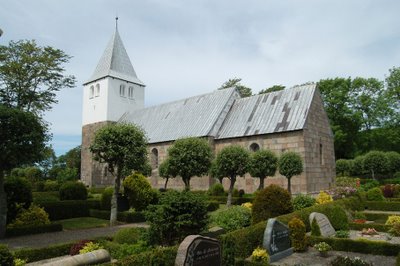
Nors Church, Thy, 7 km north of Thisted
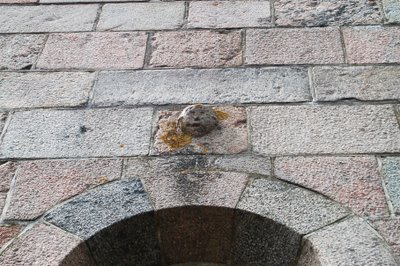
The simply carved head above the window place

Stone Mason marks
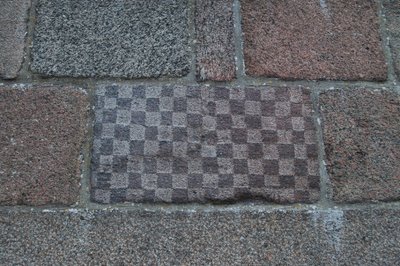
Chessboard pattern
The Romanesque church in Nors is situated upon an idyllic church yard near Nors Sø. (Lake). The church has a Romanesque choir and nave with three late Gothic additions: a tower to the west and a porch and a sacristy (now burial chapel) to the north. Choir and nave are built in the second half of the 1100s in granite ashlars. The three additions are primarily built in monk bricks, but both by the tower and the sacristy are also re-used granite ashlars from demolished walls. Besides two straight angled doors , of which the north door is in use and the south door bricked-up , and the nave has as the only church in the district (except Vestervig church) a western portal leading to the bottom room of the tower. This portal is also straight angled, but on the inside it has a smooth thympanum field with a wedge-pattern. From the original windows the north window of the choir is completely preserved with a monolit coverstone and sill. The east window of the choir is an inside niche. At the choir gable is a above the window place a protruding very raw carved head in granite, and in the walls are several stone mason fields.
The church has inside beamed ceilings and all the walls are contrary to usual practice dressed in well carved ashlars - the large choir arch has profiled kragsten. At the north side of the choir was in the 1500s added a sacristy, the bottom section built in ashlars and above yellow monk bricks. The room which is connected to the choir via a flat-curved door is cross-vaulted and was in 1750 furnished as a burial chapel. The porch is likely from the same time as the sacristy, but built all in monk bricks. The round-arched door was later changed and a flat curved hole in the east wall was replaced by a new flat curved window. The cross vault was taken down in the 1870 and replaced with a flat ceiling. The slim tower is also from the late Gothic period, the south and west side are in ashlars, possibly first from ab. 1800 with materials from the in 1794 demolished church in Torup, but the rest of the tower is monk bricks. Above the round-arched twin-peepholes the tower is crowned with a high square spire. According to a drawing by Abildgård was at the triumph arch the painted coat of arms for Las Ovesen Rød and the coat of arms for the family Munk with the initials MMD and the year 1582.
In the Romanesque communion table which is in granite ashlars with a profiled plate, was in 1891 found a reliquary with a hiding place in lead , containing seven bone splinters and furthermore two silvercoins from the 1500s. The altar piece is a painting by A. Dorph from 1883. A Romanesque granite font of Tybo-type, but four-leaved with almost vertical sides. A square brass baptismal basin from ab. 1650. A choir arch crucifix from ab. 1500 upon a new cross. A pulpit in Renaissance from ab. 1590-1600 with the coat of arms and initials of Las Ovesen Rød and wife D.... Jensdatter Vognsen. A parish clerk stool from 1641. In the western section of the nave is a large gallery from 1641 with paintings of landscapes and Nors church from 1679. The church ship is from the beginning of the 1700s. Church bell from 1842 by P.P. Meilstrup, Randers.
The church yard is surrounded by granite boulder dikes, in which is a big brick-gate from 1626 with a round arched carriage gate and a wicket.

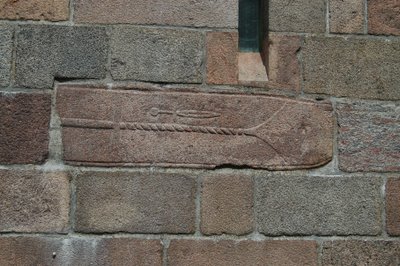
Two Romanesque gravestones
On the church yard and in the church wall are four Romanesque gravestones: 1) one with a crumbled cross; 2) one with a decoration of winding vines, found in 1941; 3) one by the church wall with cross and sword is placed between two cross-decorated gablestones, found in 1941 4) and above this in the church wall is a gravestone with a relief cross and 'uldsax'.
Names in the Middle Ages and 1600s:
Nors (1343 Nors); Hinding (*1468 Hinning, 1600 Hinnding); Øster Skårup (1580 Skaarup, 1638 Skorup); Søgård (* 1400 Siøegaardt, 1482 Søgard); Døvhule (1586 Døfhal); Vorringgård (1599 Vorninggaaard); Øregård (1477 Yrigardh, 1600 Ørgrdt); Vestergård ( 1600 Westergrdt).
The manor Søgård was in 1482 owned by Las Johansen Rød (family Lunov), in 1516 by his widow Anne Ovesdatter and their sons Johan and Ove Lauridsen and a son-in-law Erik Apend. 1540 Anne Rød (Eriks Spend's widow) was the owner of Søgård. The family Rød were the owners until 1609. Various owners (Sehested, Lykke, Dige, Søegård, Gersdorff etc.) until present.
The medieval manor Søgård was probably built at the same place as the present farm Søgård. The place seems characteristic for a late medieval plan . The places seems to be characteristic for a late medieval plan in spite of modern changes.
In 1343 the former drost Peder Vendelbo pawned his two farms in Nors to Niels Mogensen.
The væbner Mogens Borre in Hinding is mentioned in 1468.
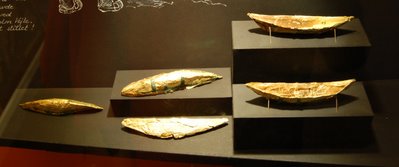
Gold Boats, Thisted Museum
Listed prehistorics:
A long barrow Dåsen, 40 m long, at Hinding and 15 hills, i.e. Thorshøj south of Nors and a large hill at Skibstedgård.
In an urn found by Thorshøj were about 100 little boats made of paper-thin gold from Bronze Age, supposedly a sacrifice - in another urn nearby was a gold ring.
See on blog: Gold Boats
The gold boats are in: Thisted Museum
photo 14 June 2006: grethe bachmann, Nors church, Thy, North Jutland & Thisted Museum.
No comments:
Post a Comment